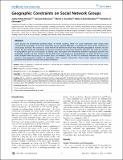| dc.contributor.author | Onnela, Jukka-Pekka | |
| dc.contributor.author | Arbesman, Samuel | |
| dc.contributor.author | Gonzalez, Marta C. | |
| dc.contributor.author | Barabasi, Albert-Laszlo | |
| dc.contributor.author | Christakis, Nicholas A. | |
| dc.date.accessioned | 2011-10-13T13:41:44Z | |
| dc.date.available | 2011-10-13T13:41:44Z | |
| dc.date.issued | 2011-04 | |
| dc.date.submitted | 2010-12 | |
| dc.identifier.issn | 1932-6203 | |
| dc.identifier.uri | http://hdl.handle.net/1721.1/66232 | |
| dc.description.abstract | Social groups are fundamental building blocks of human societies. While our social interactions have always been constrained by geography, it has been impossible, due to practical difficulties, to evaluate the nature of this restriction on social group structure. We construct a social network of individuals whose most frequent geographical locations are also known. We also classify the individuals into groups according to a community detection algorithm. We study the variation of geographical span for social groups of varying sizes, and explore the relationship between topological positions and geographic positions of their members. We find that small social groups are geographically very tight, but become much more clumped when the group size exceeds about 30 members. Also, we find no correlation between the topological positions and geographic positions of individuals within network communities. These results suggest that spreading processes face distinct structural and spatial constraints. | en_US |
| dc.description.sponsorship | National Institute on Aging (grant P01 AG-031093) | en_US |
| dc.description.sponsorship | United States. Office of Naval Research (grant ONR N000141010968) | en_US |
| dc.description.sponsorship | Network Science Collaborative Technology Alliance (grant ARL NS-CTA W911NF-09-2-0053) | en_US |
| dc.description.sponsorship | United States. Defense Threat Reduction Agency (grant DTRA BRBAA08-Per4-C-2-0033) | en_US |
| dc.description.sponsorship | United States. Defense Threat Reduction Agency (grant DTRA WMD BRBAA07-J-2-0035) | en_US |
| dc.description.sponsorship | National Science Foundation (U.S.) (grant NSF BCS-0826958) | en_US |
| dc.description.sponsorship | James S. McDonnell Foundation (grant JSMF 220020084) | en_US |
| dc.language.iso | en_US | |
| dc.publisher | Public Library of Science | en_US |
| dc.relation.isversionof | http://dx.doi.org/10.1371/journal.pone.0016939 | en_US |
| dc.rights | Creative Commons Attribution | en_US |
| dc.rights.uri | http://creativecommons.org/licenses/by/2.5/ | en_US |
| dc.source | PLoS | en_US |
| dc.title | Geographic Constraints on Social Network Groups | en_US |
| dc.type | Article | en_US |
| dc.identifier.citation | Onnela J-P, Arbesman S., Gonzalez M.C., Barabasi A-L, Christakis N.A. (2011) "Geographic Constraints on Social Network Groups." PLoS ONE 6(4): e16939. | en_US |
| dc.contributor.department | Massachusetts Institute of Technology. Department of Civil and Environmental Engineering | en_US |
| dc.contributor.approver | Gonzalez, Marta C. | |
| dc.contributor.mitauthor | Gonzalez, Marta C. | |
| dc.relation.journal | PLoS ONE | en_US |
| dc.eprint.version | Final published version | en_US |
| dc.type.uri | http://purl.org/eprint/type/JournalArticle | en_US |
| eprint.status | http://purl.org/eprint/status/PeerReviewed | en_US |
| dspace.orderedauthors | Onnela, Jukka-Pekka; Arbesman, Samuel; González, Marta C.; Barabási, Albert-László; Christakis, Nicholas A. | en |
| dc.identifier.orcid | https://orcid.org/0000-0002-8482-0318 | |
| mit.license | PUBLISHER_CC | en_US |
| mit.metadata.status | Complete | |
